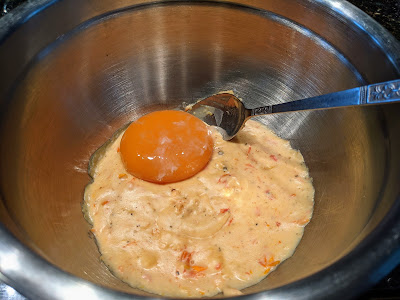In the past two chili competitions our friends host, we've come in #2 and #1; we hope to keep our crown this year with a pork-based chili that focuses on smoke. It uses smoked pork, smoked oil, smoked tomatoes, smoked tomato water, and smokey chilis.
TL;DR: we came in tied for 2nd place in this year's competition!
Smoked Tomatoes and Tomato Water
We got bulk tomatoes from the farmers market.
To skin easily: freeze hard, remove, and soak each for a minute or two in water.
Nick the skin in an X at the bottom and peel it off; it should slip off pretty easy, but if not, let soak a minute more and try again.
While still semi-frozen, cut each in half at the equator.
Put on wire racks, cut-side down, over trays (like lasagna pans) to catch the drips as they thaw and smoke.
Cold smoke several hours.
You may be able to do this while you smoke the Pork and Oil below, if you've got lots of room.
Keep the tomatoes and water to make the chili.
Both are great for other uses, and the smokey water makes a fantastic Bloody Mary.
Pork
1 Kg 2 Lb Pork Shoulder, with a moderate amount of fat
1 L 1 Qt Olive Oil (as much as you want, it's versatile)
Cut Pork into strips that will fit into meat grinder; arrange on wire rack.
Fill a large low tray -- a lasagna tray -- with Olive Oil and add to smoker.
Cold smoke Pork and Oil; we used apple wood pellets in an 18-inch stainless perforated tube, works well.
Flip the meat periodically to expose all sides.
This smoking runs a bit over 4 hours.
Chill Pork hard before grinding.
Grind through coarse plate, about 3 mm wholes.
Sear in a little of the now Smoked Olive Oil.
The Pork threw off 43g of fat, leaving 607g meat.
Reserve the fat for sauteing later.
Beans
225 g 8 oz Dried Black Beans (Frijoles negros, secos)
1 L 32 fl oz Smoked Tomato Water
Cook beans in Tomato Water, covered, very low, until nearly tender, add water if needed; may take 1-4 hours.
Drain, reserve smokey bean liquid.
Chili Sauce Base
Build a base using Irene's Vegan Chili, sans chick peas, and substituting as many smoked ingredients as we can find -- smoked chipotles, smoked oil, smoked tomatoes, ...
17 g 7 whole Chipotle chilis, dried
15 g 3 whole Sweet dried chilis (Costeño, New Mexico, Choricero)
52 g 3 whole Fruity dried chilis (Ancho, Mulatto, Negro, Pasilla)
1 L 1 quart Smoked Tomato Water and smokbean-cooking liquid
Remove stems and seeds from Chilis.
Microwave chilis between two plates in 10 second increments until pliable and toasty smelling, about 30 seconds total.
Add Chilis to Smoked Tomato Water, cover, and microwave until it simmers, about 5 minutes.
Transfer to blender and blend until smooth -- be careful, the hot liquid can explode, so start with slow pulses and cover loosely with a paper towel.
Makes 4 Cups.
Assembly
230g 1 large Onion, diced
? g 3 clove Garlic, minced
10 g 1.5 Tbs Cumin seed, toasted, ground
3.5 g Fresh Oregano, or 2 tsp Dried, minced
10 g ? Pimenton
400 g 14 oz Tomatoes, preferably smoked, fine chopped
? g 3 whole Chipotle chilis from a can, chopped
? g 1 Tbs Chipotle can sauce
95 g Smoked dried Chipotle peppers, rehydrated
20 g Poblano Chilis from the garden, seeded, chopped
? g 1 tsp Marmite or Vegemite (for Umami)
? g 1 Tbs Soy Sauce (for Umami)
Saute Onions in rendered pork fat, then add Garlic, Cumin, Oregano; drain, reserving fat.
Add part of the drained fat to a large pot for final assembly, and fry chopped tomatoes in the fat.
Add cooked Onion mixture and cooked Pork.
Add Pimenton, chopped Chipotles and their sauce (this was a 4 ounce jar's worth)
Add 2 C of the 4 C blended Chili sauce, since we had less meat than expected.
Let cook a bit to combine, then adjust salt.
Cook covered, low, until meat is tender, maybe another hour.
Add the 1 C of cooked Beans; this proportion seemed high at first but turned out fine.
Cook a bit more to finish, or let cool, refrigerate, then reheat the next day when the flavors will be married.
If the chili is too loose, or maybe has a bit too much fat, create a slurry of Masa in a little water and add it to the chili a tablespoon at of time until it's thickened as much as you want.
I like to serve this over spaghetti ("chili mac"), with grated Parmesan or Cheddar -- better, smoked Mexican cheese like Cojita -- and some diced onions or scallions.
For the competition, use 1 C Black Beans; for home, use 3 C.










































